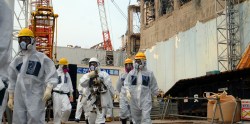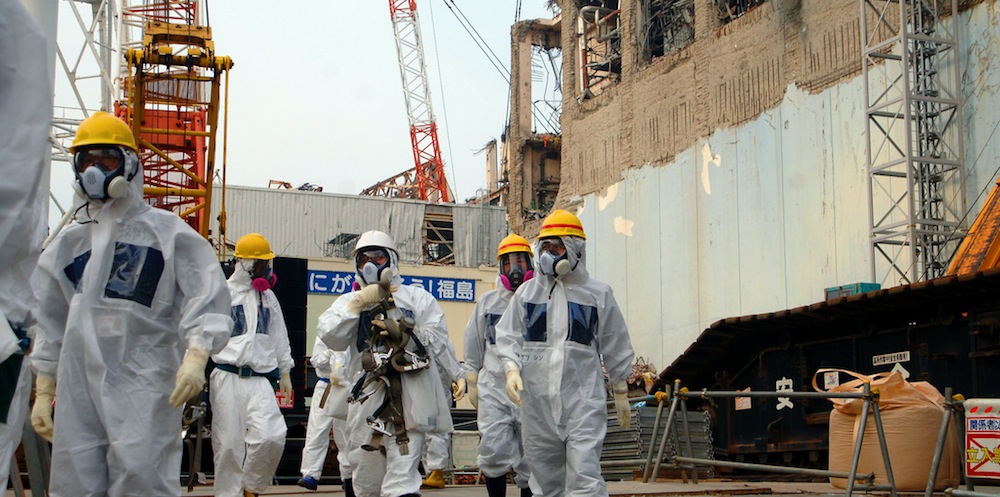
IAEAInternational inspectors visiting Fukushima in April.
Fuku-what?
Two years after the Fukushima Daiichi meltdown, Japan’s government is inviting utilities to file the paperwork needed to fire back up their idled nuclear reactors. Never mind that many Japanese citizens think that’s a terrible idea.
Japan is home to 50 reactors, which provided about a third of the country’s electricity until the March 2011 earthquake and tsunami triggered the meltdown. Just two of those reactors are currently producing power, with the rest shut down as a precaution. But the number of operational reactors could gradually begin rising. From The Japan Times:
Japan on Monday reopened procedures to allow idled reactors to be brought back online, putting in place new nuclear regulations that reflect the lessons learned from the 2011 Fukushima No. 1 meltdown disaster.
While power utilities are expected to rush to file applications with the Nuclear Regulation Authority for safety assessments on a total of 10 reactors, none will be restarted anytime soon, because it may take around six months for each safety-screening process to finish.
Facing what the NRA calls the world’s toughest level of nuclear regulations, utilities may also opt to give up efforts to restart some of the country’s 50 commercial reactors and scrap them instead of investing in costly safety measures.
There is strong economic pressure within Japan to restart the nuke plants. From Bloomberg:
Tokyo Electric, Japan’s biggest utility better known as Tepco, said earlier this week that it would seek permission to start the Kashiwazaki-Kariwa plant as soon as possible. The utility, which had a 685.3 billion yen ($6.8 billion) loss last fiscal year, said in May 2012 that it would return to profit this year if it’s allowed to restart the reactors at the plant. …
Combined with rate increases planned for sometime before October, the restarts would enable those utilities to become profitable again during the fiscal year ending March 2015 by reducing their fuel bills, [energy analyst Hidetoshi] Shioda said.
Japan’s nine utilities with atomic plants reported combined losses of 1.59 trillion yen in the year ended March 31. Only Hokuriku Electric Power Co. posted a profit, ending the year 100 million yen ahead.
Japan has relied on traditional fuel sources to fill much of its energy gap since Fukushima, paying 24.7 trillion yen for fossil fuels in the year ended in March, up 36 percent from the 12 months before the disaster.
It’s been more than two years since the Fukushima accident, but the site of the meltdown remains a harrowing reminder of the dangers of nuclear power.
Tepco is still struggling to contain radioactive water used to cool radioactive rods at the crippled power plant. Groundwater under the plant was recently confirmed to be toxic. Out-of-work fishermen are being hired to pull fish from the sea for scientific tests — and those tests are finding that the fish are radioactive.
Some 150,000 people are still unable to return to their homes, and Fukushima Prefecture estimates that 1,415 evacuees have died in shelters since the accident — deaths that are being ruled disaster-related. Twenty-nine people are believed to have killed themselves in the wake of the tragedy.
From a Japan Times editorial published last month:
Thousands of protesters took to the streets last Sunday, rallying in Tokyo’s Shiba and Meiji parks and marching to the Diet area to protest against nuclear power. The organizers of the rally claimed that 60,000 people ringed the Diet Building, though the Metropolitan Police Department put the number at 20,000 to 30,000.
Whatever the exact number, the rally was another expression of deep-seated opposition to nuclear power in Japan. The central government should recognize rallies like this as an important expression of political opinion.
Unfortunately the government appears not to be listening. Neither are they paying attention to the countless problems with the cleanup of the Fukushima No. 1 nuclear power plant, whose meltdown is Japan’s worst nuclear disaster.
The disaster has displaced some 150,000 people and left others living in fear of exposure to radiation. Every day, a new problem is announced by Tokyo Electric Power Co., whether it’s rats eating electric lines or another tank leaking radioactive water. The proposed solutions, whether to expand the number of storage tanks or to make frozen walls in the soil to lessen leakage, show little progress and much desperation.
Power companies and the central government do not seem to be listening to scientists, either.



